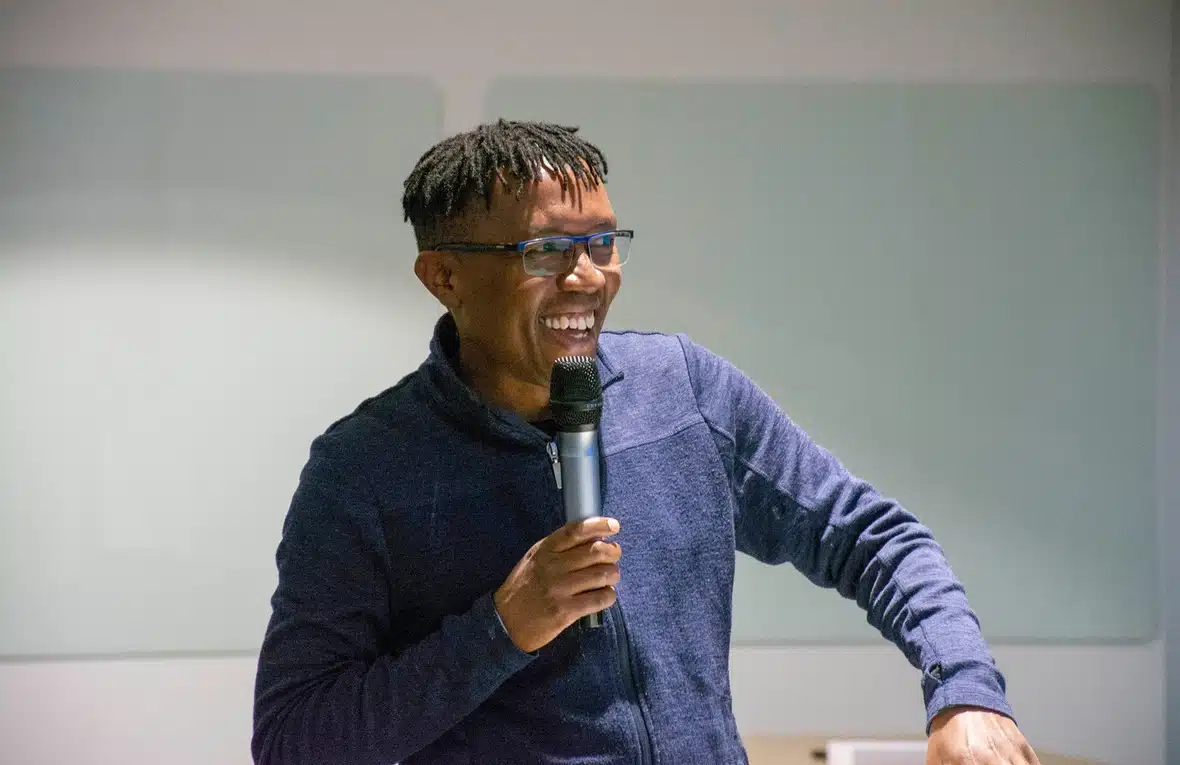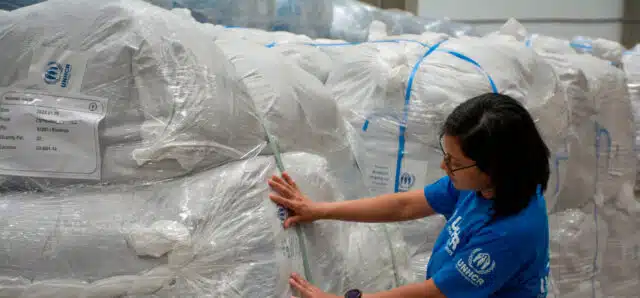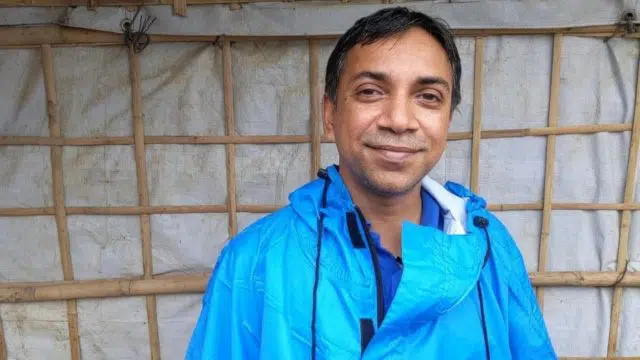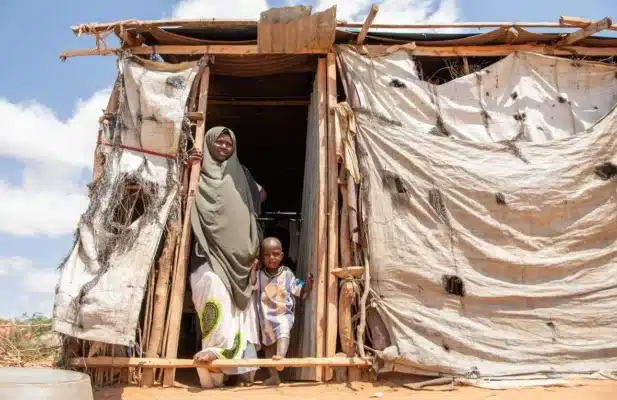
Ben Safari, head of UNHCR’s Supply Management Service. © UNHCR/Timea Vanka
As the head of supply management at UNHCR, Ben Safari is leading efforts to reduce our carbon footprint and make the provision of aid to forcibly displaced people more sustainable
By Kristy Siegfried
Ben Safari has gone from being a recipient of the UN Refugee Agency’s assistance after he was displaced by the war and genocide in Rwanda during his 20s, to leading the service responsible for sourcing, procuring and delivering UNHCR’s life-saving aid to people forced to flee.
Early on in his career, he understood that providing that assistance should not come at a cost to the environment. He talked to global web editor Kristy Siegfried about the vital work he and his team have done to reduce UNHCR’s carbon footprint and make its supply chain more sustainable.
What drew you to this type of work?
I was born in Rwanda, and Rwanda is a very beautiful country. The weather is always nice, the green is very green, and I grew up imagining that the world is like that. Then we had a genocide and a war in 1994, and things changed.
My first contact with UNHCR was while I was displaced, and I remember when the war was over a big convoy of white trucks came to transport us back home from where we had fled. I told my family I wanted to drive a big four-wheel-drive vehicle and distribute supplies, like the UN and other NGOs did. I got lucky and found a job at Catholic Relief Services (CRS). My job was to distribute food to internally displaced people and manage the logistics.
Later, after five years of studying in Australia, I went to West Africa for CRS. I was in the Sahel region, where trees were few and far between, where the landscape was very dry and arid, where it rained once a year for a couple of months. That really showed me how the climate is making things very difficult for people: the Sahara Desert is moving south and increasing significantly, making life and livelihoods more and more fragile every year.
On trips across the Sahel with my family we started noticing trees and shrubs with black plastic bags hanging on them. My kids were calling them plastic bag birds because from far away, they looked like birds. And so that just triggered my imagination on how [human] activity can cause environmental issues.
At the same time, we started looking at how we can improve packaging [of aid]. We were giving out oil in jerrycans and food in bags, and months after … you went to the village and found all these jerrycans littered around the village. To me, it’s not good enough to say they needed whatever is in the bag or in the can. That’s when I started working on improving how we sustainably offer humanitarian assistance to people.
What are some of the environmental impacts of the core relief items (CRIs) that UNHCR distributes?
At UNHCR, we buy a lot of plastic – blankets are made from plastic, tarpaulins are made from plastic, sleeping mats are made from plastic. The packaging that we provide those items in is made from plastic – which can all leave behind waste.
We ship [items] all around the world, sometimes to remote locations that do not have waste management facilities in place. Even the vehicles we have — and we have the largest fleet in the UN — contribute to increased CO2 emissions.
What are we doing to try to reduce those impacts?
We looked at what we buy and where we’re likely to be producing the highest emissions and we found that our supply activity accounts for an estimated 60 per cent of UNHCR’s overall carbon emissions. We further identified 10 products that actually contribute the lion’s share of that pollution. That is where our immediate climate action is directed.
The sustainability strategy aims to reduce the carbon footprint from the goods that we buy, and from transport and storage, by 20 per cent by 2025. And that’s only the beginning for us.
One part of the strategy is a full redesign of our CRIs, starting with six items – blankets, sleeping mats, jerrycans, buckets, solar lamps and kitchen sets.
The primary thing that we have done is to make them as much as possible from recycled materials. Secondly, we’ve removed all single-use plastics from packaging and replaced them with biodegradable material or more durable items like brown paper, or durable packaging that you can actually reuse.
In addition, we’re looking at durability, repairability and how an item is repurposed or disposed of at the end of its useful life in a way that minimizes its environmental impact.
A lot of our carbon emissions come from international transport, so we’re also looking at how we can diversify our sourcing. You can buy a product that is sustainable when it comes from the factory, but if you buy a blanket from China and transport it to Panama, where we have a big warehouse, and then to Venezuela for distribution, that blanket has travelled a significant amount and used a lot of fuel. If you can buy the blanket in say Brazil or Mexico, it may have less recycled content, but because it hasn’t travelled as far, it’ll end up being more sustainable and it’s helping the local industry.
How do you convince suppliers to switch to more sustainable materials and production methods?
We simply say we’re including this now as part of our evaluation mechanisms, and we’ll come to check. They all understand that business is different now. And, in many instances, the manufacturers have been making changes towards more sustainable products faster than the humanitarian industry, for commercial reasons.
We’re looking at not just the materials [they use], but also the manufacturing process – how much electricity and what energy source are you using? How much water you’re using to heat or cool or wash? How many additives, such as colours or cleaning agents are you using?
We do recognize that some of these are not overnight changes. Some of this is really about first changing behaviour, changing thinking, and imagining the use of an item beyond its “as new” state.
How does this work ultimately benefit refugees?
What is good for our planet is also good for people: everything is interconnected, and we must consider the impact of any humanitarian actions on future generations.
There are also big opportunities for refugees and host communities. Let’s take, for example, solar lanterns. We are working with suppliers to check whether they can set up small repair shops and issue replacement parts for the lanterns we distribute so that refugees can set up shop and repair them. We’re also working with people who are creating small, artisanal recycling plants so that when we distribute in a location, they can collect the plastic and recycle it into, for example, roofing sheets.
How are you working with other humanitarian agencies to ensure this is all part of a broader effort?
We are collaborating and engaging with a number of UN entities and NGOs. Some of them are advanced in many ways, some of them are only really beginning to think about this.
With our results, we can show how easy this is – if you focus on it, if you give it attention – and we can lead the rest of the industry in reducing our carbon footprint.
From a 20 per cent [cut in emissions] by 2025, which we are already reaching, I’m now pushing for 30 per cent by 2030, not just by UNHCR, but by all the humanitarian actors.
How far have we come in terms of making our supply chain more sustainable? What are the next steps?
We’re changing the world of supply in humanitarian work as we know it. From no one talking about it, it’s become the biggest focus of our supply work.
We have changed the five biggest polluting items in UNHCR without increasing our cost. We have reduced our costs overall and we will reduce them more. The proof of concept is already there.
We’re really going beyond procurement, beyond our usual area of professional work. Now we’re going full life cycle – with the refugees, with the other humanitarian actors, with our colleagues, with the suppliers. We’re going into things like waste management, in the most remote and under-served environments.
Because this goes deeper than the usual turf, we need collaboration across divisions, across teams, across regions.
Originally published by UNHCR on 13 September 2023.





